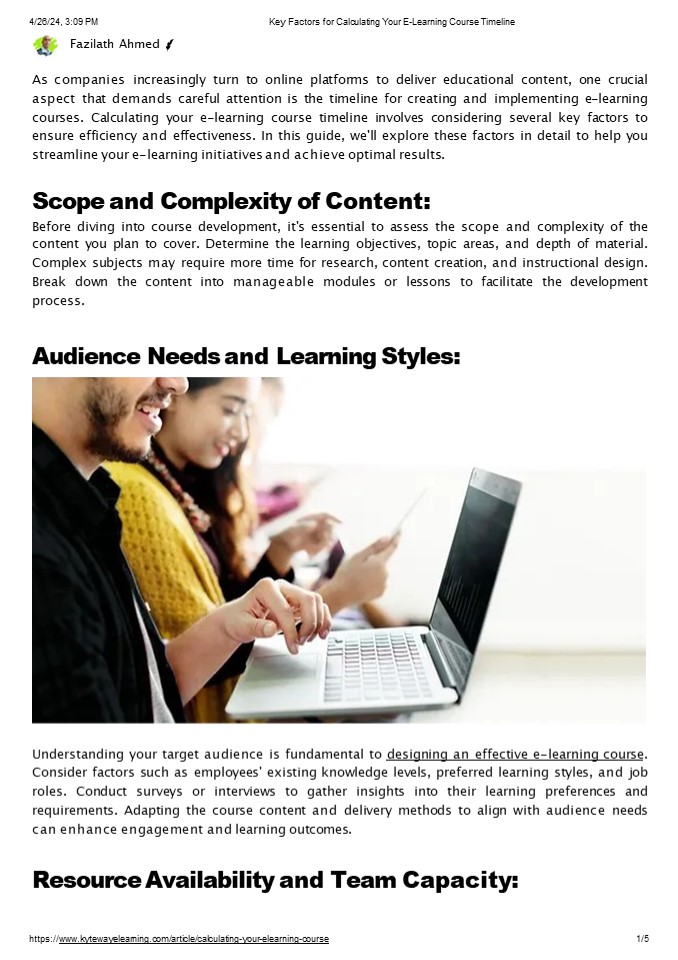Calculating Your E-Learning Course Timeline: Key Factors to Consider - PowerPoint PPT Presentation
Title:
Calculating Your E-Learning Course Timeline: Key Factors to Consider
Description:
Calculating your e-learning course timeline requires consideration of key factors to ensure effective planning and execution. Begin by outlining course objectives, content complexity, and desired interactivity levels to estimate development time accurately. Factor in review cycles, feedback incorporation, and quality assurance processes to account for potential delays and ensure timely delivery. – PowerPoint PPT presentation
Number of Views:1
Date added: 3 May 2024
Slides: 6
Provided by:
vinaybommena
Category:
How To, Education & Training
Tags:
Title: Calculating Your E-Learning Course Timeline: Key Factors to Consider
1
4/26/24, 309 PM
Key Factors for Calculating Your E-Learning
Course Timeline
Fazilath Ahmed As companies increasingly turn to
online platforms to deliver educational content,
one crucial aspect that demands careful attention
is the timeline for creating and implementing
e-learning courses. Calculating your e-learning
course timeline involves considering several key
factors to ensure efficiency and effectiveness.
In this guide, we'll explore these factors in
detail to help you streamline your e-learning
initiatives and achieve optimal results. Scope
and Complexity of Content Before diving into
course development, it's essential to assess the
scope and complexity of the content you plan to
cover. Determine the learning objectives, topic
areas, and depth of material. Complex subjects
may require more time for research, content
creation, and instructional design. Break down
the content into manageable modules or lessons to
facilitate the development process.
Audience Needs and Learning Styles
Understanding your target audience is fundamental
to designing an effective e-learning course.
Consider factors such as employees' existing
knowledge levels, preferred learning styles, and
job roles. Conduct surveys or interviews to
gather insights into their learning preferences
and requirements. Adapting the course content and
delivery methods to align with audience needs can
enhance engagement and learning outcomes.
Resource Availability and Team Capacity
https//www.kytewayelearning.com/article/calculati
ng-your-elearning-course
2
4/26/24, 309 PM Key Factors for Calculating Your
E-Learning Course Timeline Assess the resources
available for course development, including human
resources, technology, and budget. Determine the
size and composition of your e-learning
development team, including subject matter
experts, instructional designers, multimedia
specialists, and project managers. Collaborate
closely with team members to establish clear
roles, responsibilities, and deadlines to ensure
efficient progress.
Technology Infrastructure and Tools When
planning your e-learning course, it's important
to take a close look at the tech tools and
platforms you'll need. This means figuring out
which Learning Management System (LMS) works
best, the kind of authoring tools you need for
creating your content, the multimedia software
that'll make your course engaging, and where
you're going to host all of this online. But it's
not just about picking tools off the shelf you
need to make sure they all play nicely together,
making your life easier when it comes to putting
together your course, getting it out to your
learners, and keeping track of how it's going.
Now, about choosing the right authoring tool,
it's like finding the right key for a lock.
You've got to really understand what you need
before you start looking. What does your course
need to do? How complex does it need to be? Find
an authoring tool that fits those needs like a
glove. And remember, having these tools is one
thing, but making the most of them is another.
Iterative Development and Feedback Loops
https//www.kytewayelearning.com/article/calculati
ng-your-elearning-course
3
4/26/24, 309 PM
Key Factors for Calculating Your E-Learning
Course Timeline
Adopt an iterative approach to course development
that allows for ongoing refinement based on
feedback and evaluation. Build feedback loops
into the development process to gather input from
stakeholders, subject matter experts, and
learners. Incorporate formative assessments,
surveys, and usability testing to identify areas
for improvement and make necessary adjustments
before finalizing the course. Regulatory and
Compliance Requirements In corporate settings,
e-learning courses often need to adhere to
regulatory standards and compliance requirements.
Research relevant industry regulations,
certifications, and internal policies that impact
course content and delivery. Allocate sufficient
time for compliance review, approval processes,
and any necessary revisions to ensure that your
e-learning initiatives meet legal and regulatory
obligations.
Project Management and Timelines
https//www.kytewayelearning.com/article/calculati
ng-your-elearning-course
4
4/26/24, 309 PM
Key Factors for Calculating Your E-Learning
Course Timeline
Develop a comprehensive project plan with clear
timelines, milestones, and deliverables to guide
the course development process. Utilize project
management methodologies such as Agile or
Waterfall to organize tasks, track progress, and
manage potential risks. Set realistic deadlines
for each phase of development while allowing
flexibility for unexpected challenges or changes
in scope. Pilot Testing and Evaluation Before
launching your e-learning course company-wide,
conduct pilot testing with a small group of
learners to gather feedback and assess
effectiveness. Monitor learner engagement,
comprehension, and performance metrics during the
pilot phase. Use this data to fine-tune the
course content, navigation, and interactive
elements for optimal impact. Incorporate
summative evaluation measures to assess the
overall success and ROI of the e-learning
initiative. By carefully considering these key
factors, you can develop a realistic and
effective timeline for your e-learning course
that aligns with organizational goals and learner
needs. Remember that successful e-learning
development requires collaboration, adaptability,
and a commitment to continuous improvement. By
investing time and resources upfront to plan and
execute your e- learning initiatives
thoughtfully, you can enhance employee skills,
productivity, and satisfaction within your
organization.
https//www.kytewayelearning.com/article/calculati
ng-your-elearning-course
5
4/26/24, 309 PM Conclusion
Key Factors for Calculating Your E-Learning
Course Timeline
In conclusion, calculating your e-learning course
timeline is a multifaceted process that involves
balancing various factors such as content
complexity, audience needs, resource
availability, technology infrastructure,
regulatory requirements, project management,
and evaluation strategies. By addressing these
considerations systematically, you can create
high-quality e- learning experiences that drive
positive outcomes for your organization and its
employees.
https//www.kytewayelearning.com/article/calculati
ng-your-elearning-course

